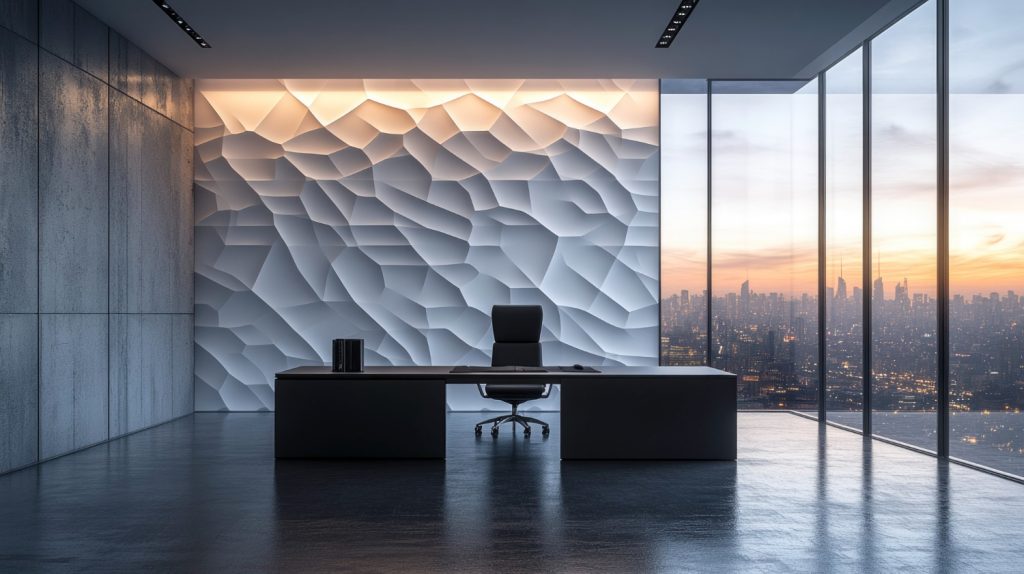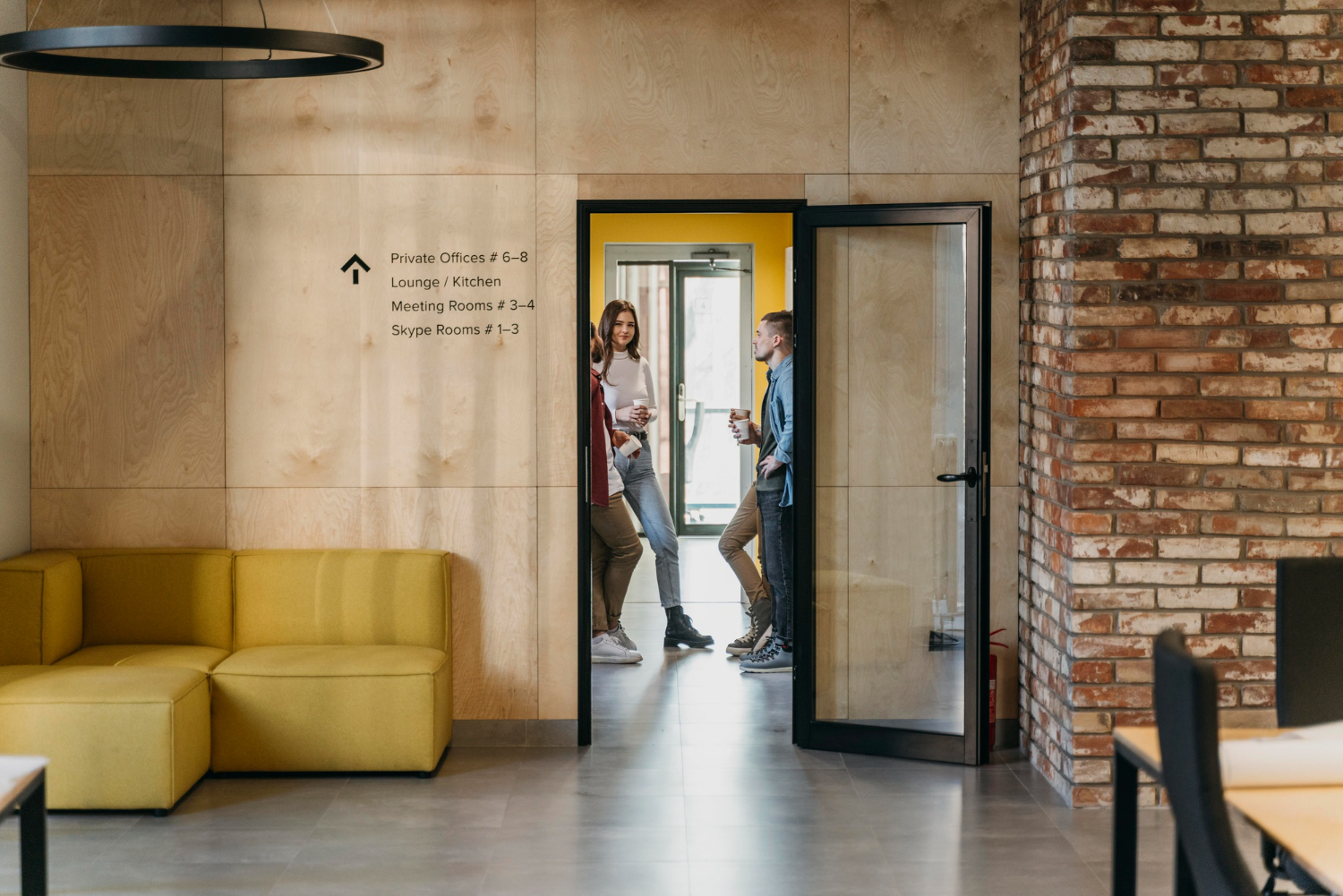At its core, the debate often boils down to practicality, aesthetics, and maintenance. Paint is celebrated for versatility and ease of change, perfect for those who love to reinvent their space with a fresh coat on a whim. It’s generally simpler to apply and touch up, offering a wide range of finishes that can cater to various style preferences.
Wallpaper —https://www.wallmur.com/— on the other hand, brings a different kind of allure. Its texture and intricate designs can add dimension and richness to a room, often achieving effects difficult to replicate with paint. It can serve as a powerful style statement, though it requires a bit more commitment due to its complex application and removal processes.
Table of Contents
Infuse Your Brand Identity Into The Workspace
On the other hand, wallpaper has made a significant comeback, particularly in business office settings. It offers a sense of sophistication and can dramatically elevate the look of a professional space. Modern wallpapers come in a variety of textures, patterns, and designs, making them a popular choice for companies wanting to make a lasting impression. With options that include everything from subtle, calming prints to bold, statement designs, wallpaper allows businesses to infuse their brand identity into the workspace.
Moreover, wallpaper often proves more durable than paint, especially in high-traffic areas like offices. While the upfront cost may be higher, the long-term investment pays off as wallpapers typically last longer and require less frequent touch-ups. In a business office environment where professionalism and aesthetics are key, wallpaper can create an ambiance that is both inviting and impressive, contributing positively to employee morale and client perception.

When considering maintenance, modern wallpapers are easier to clean and maintain than in the past, making them a practical solution for busy office environments. In spaces where creating a distinctive atmosphere is crucial, wallpapers offer a balance between aesthetics and longevity that paint may not always provide.
Durability and Maintenance
Paint
Generally, a good quality interior paint can last 5-10 years, depending on the wear and tear of the room. It’s easier to touch up than wallpaper, but it might require more frequent maintenance in high-traffic areas.
Making Paint More Durable
- Quality of Paint—Investing in high-quality paint is the first step. Look for paints labeled as “washable” or “scrubbable,” which stand up better to cleaning and wear.
- Preparation and Application—Proper surface preparation is crucial. Ensure the walls are cleaned, primed, and any holes are filled before painting. Applying two coats can enhance durability as well.
- Finish Matters—For high-traffic areas, consider satin, semi-gloss, or gloss finishes. They’re not only more durable but also easier to clean than flat or matte options.
- Cleaning Regimen—Instead of frequent washing, which can wear down the paint, gently dust or vacuum walls regularly to keep them clean. When necessary, use a damp cloth with mild soap to tackle any marks.
Wallpaper
Offering greater durability in many cases, wallpaper can withstand the test of time more robustly than paint. Many new options are scrubbable, making maintenance easier. However, if a section gets damaged, repairs can be trickier than just dabbing on some extra paint.
Maximizing Wallpaper Durability
- Choice of Material—Vinyl wallpapers are particularly durable and suitable for busy households. They’re easy to clean and can tackle moisture better than paper-based ones.
- Installation Techniques—Professionally installed wallpaper usually holds up better as bubbles and tears are minimized.
- Handling Repairs—Keep spare wallpaper for patching up any damage. Learning some simple repair techniques can help you maintain the look over time.
- Household Etiquette—Encouraging gentle behavior around wallpapered areas is beneficial. Perhaps channel youthful exuberance towards more wallpaper-friendly pastimes? Easier said than done, I know!
Variety and Design Flexibility
Paint
The sky’s the limit with paint. You have a seemingly infinite color palette and can easily experiment with techniques like ombre, stenciling, or stripes. Plus, paint finishes range from matte to high gloss, each giving your space a different vibe.
Bringing in a Painting Virtuoso
A skilled artist can create stunning wall murals that rival elegant wallpapers. This approach beautifully combines creativity and customization, but it can get pricey. Consider this if you’re aiming for a standout feature wall rather than an entire room makeover.
Wallpaper
With wallpaper, you can harness intricate patterns and textures that paint can’t replicate—think florals, geometrics, or even tactile finishes like grasscloth. Some modern wallpapers mimic murals, offering breathtaking visuals that require zero artistic skill on your part.
Application and Remodel Impact
Paint
It tends to be the more straightforward option for DIYers. When the mood strikes to refresh, painting over tired walls is relatively simple, assuming a smooth surface.
Keep in mind that moving from darker to lighter paints often means additional coats or primers to prevent color bleed-through. With wallpaper, it can mask previous shades, but careful pattern matching is key.
Wallpaper
While installation can be more tedious, particularly for intricate patterns or non-peel-and-stick varieties, it can make a bold statement. Deciding to change styles often means stripping back layers, which is more involved.
Cost Considerations
Paint
Typically, paint is more budget-friendly upfront, though high-end paints can rival the cost of wallpaper.
Wallpaper
Initial costs can be higher, especially with quality paper or intricate designs, but the longevity can balance out expenses over time.
Cheap wallpapers might wear faster, leading to future costs that exceed a fresh coat of quality paint. Weigh the up-front investment against potential long-term savings.
Committing to a Mood
A space that allows for some creative maneuvering can satisfy evolving tastes. And within a room, accent walls or easily changed features can offer an adaptable spirit, encouraging those artistic inclinations.
Paint
It’s versatile. If your style frequently fluctuates or you’re prone to spontaneous makeovers, being able to rinse and repeat with fresh colors may appeal.
Wallpaper
Sets the scene with commitment. It’s perfect for when you fall in love with a particular aesthetic or design and want to marvel at it for years.
Ultimately, your choice may hang on your willingness to either revel in a dramatic statement or maintain flexibility with easier updates. Remember, rooms aren’t set in stone—what matters is what inspires you every time you walk in. Mix and match even! A feature wallpaper wall alongside painted ones might offer the best of both worlds.
Whatever direction your creative compass points, know each stroke or strip tells a little bit of your story. Stay true to your instincts, and let those walls sing with personality!
Ultimately, it all boils down to what sparks joy when you walk into that room. Whether it’s the pleasure of artful brushstrokes or the comfortable embrace of patterned paper, make sure it reflects your unique flair!
Environmental Impact
Paint
Producing paint does involve a significant chemical process. However, there are increasingly more eco-friendly and low-VOC (volatile organic compounds) paint options available. These aim to minimize toxins released during application, reducing harm for both the environment and indoor air quality.
Wallpaper
Traditional wallpapers can contribute to environmental concerns, particularly those made with PVC. There are eco-friendly alternatives made from sustainable materials like grasscloth, bamboo, and recycled content. These are produced with a focus on sustainability and biodegradability.
- Certification Marks
Whether you’re leaning toward paint or wallpaper, look for certifications like GREENGUARD, Green Seal, or Eurofins Indoor Air Comfort Gold. These indicate products tested and verified for low chemical emissions and environmental impact.
- Eco-Friendly Choices
Seek paints with natural pigments and bases, or wallpapers with water-based inks, and those made from natural fibers, avoiding vinyl-based options.
- DIY Mindfulness
Consider your waste footprint. Opt for the exact quantities you need, recycle leftover wrappings and containers properly, and follow manufacturers’ guidelines for disposal.
It’s all about aligning your choices with values that prioritize both personal health and planetary stewardship. You don’t have to sacrifice style to make eco-conscious decisions—thoughtful design and sustainability can go hand-in-hand.
Together, we’re crafting a future beautiful enough for all to enjoy!

Andrej Fedek is the creator and the one-person owner of two blogs: InterCool Studio and CareersMomentum. As an experienced marketer, he is driven by turning leads into customers with White Hat SEO techniques. Besides being a boss, he is a real team player with a great sense of equality.
